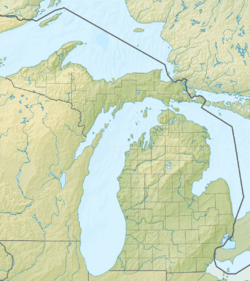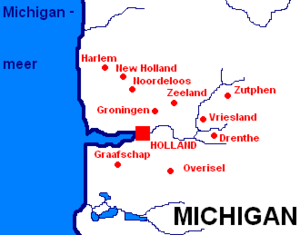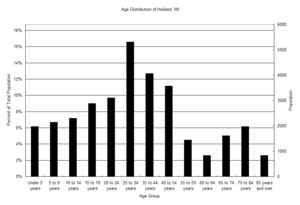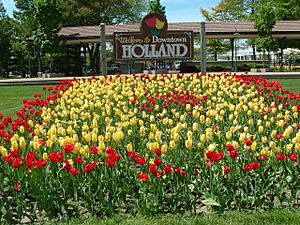Holland, Michigan facts for kids
Quick facts for kids
Holland, Michigan
|
|
|---|---|
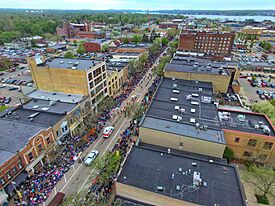
Downtown during the Tulip Time Festival
|
|
| Nickname(s):
The Tulip City
|
|

Location within Ottawa County
|
|
| Country | United States |
| State | Michigan |
| Counties | Allegan and Ottawa |
| Settled | 1847 |
| Incorporated | 1867 |
| Area | |
| • Total | 17.45 sq mi (45.20 km2) |
| • Land | 16.68 sq mi (43.21 km2) |
| • Water | 0.77 sq mi (1.99 km2) |
| Elevation | 610 ft (186 m) |
| Population
(2020)
|
|
| • Total | 34,378 |
| • Estimate
(2023)
|
34,540 |
| • Density | 2,070.74/sq mi (799.52/km2) |
| Time zone | UTC−5 (Eastern (EST)) |
| • Summer (DST) | UTC−4 (EDT) |
| ZIP code(s) |
49422–49424
|
| Area code(s) | 616 |
| FIPS code | 26-38640 |
| GNIS feature ID | 0628421 |
Holland is a city in Michigan, a state in the United States. It is located in the western part of Michigan, right by the eastern shore of Lake Michigan. The city sits on Lake Macatawa, which is connected to Lake Michigan.
Holland was started by people from the Netherlands, and many of its citizens still have Dutch family roots. The city is home to Hope College and Western Theological Seminary. Holland's economy is strong in manufacturing, farming, tourism, and education. Many well-known companies, like Herman Miller and Haworth, are based here. Every year, thousands of people visit Holland for the Tulip Time Festival. This festival celebrates the city's Dutch heritage and its beautiful tulip fields.
Contents
History of Holland
Early Settlers and Founding
The area where Holland is now located was first home to the Ottawa Native American people. In 1846, a missionary named Reverend George Smith started the Old Wing Mission there. He hoped to share his beliefs with the Ottawa people.
In 1847, a group of Dutch settlers arrived. They were led by Dr. Albertus van Raalte. These settlers came from the Netherlands because they faced tough economic times and wanted more religious freedom. They decided to settle together as a group.
The Dutch settlers chose land near the Ottawa people's mission. This land was by the Macatawa River, which flows into Lake Macatawa. The Dutch settlers and the Ottawa people did not get along well. The Ottawa people eventually moved north to keep their way of life.
Dr. Van Raalte was a very important leader in Holland's early days. He helped with religious, political, and financial matters. In 1847, he started the First Reformed Church of Holland. On March 25, 1867, Holland officially became a city. Isaac Cappon was the city's first mayor.
The Great Fire of 1871
Holland suffered a huge fire between October 8 and 10, 1871. This happened at the same time as the famous Great Chicago Fire and the deadly Peshtigo Fire in Wisconsin. Many other Michigan towns also burned around this time.
Most of downtown Holland was destroyed by the fire. One person died because of it. No one knows for sure what caused the fire. Some people thought embers from the Chicago fire blew across Lake Michigan. Others had more unusual ideas, like burning gas from a comet. The most likely idea is that strong winds made a small brush fire grow quickly. It first burned the forests nearby, then spread to the town. Even today, the exact cause of the fire is still a mystery.
Geography and Climate
Holland is located in Michigan, with parts of the city in both Ottawa and Allegan counties. The city has a total area of about 17.45 square miles (45.20 square kilometers). Most of this area is land, with a small part being water.
Neighborhoods in Holland
- Holland Heights is one of the neighborhoods in the city.
Holland's Climate
Holland has a climate with four distinct seasons. It is influenced by the Great Lakes. This means it can have warm summers and cold, snowy winters.
| Climate data for Holland, Michigan (West Michigan Regional Airport) 1991–2020 normals, extremes 1905–present | |||||||||||||
|---|---|---|---|---|---|---|---|---|---|---|---|---|---|
| Month | Jan | Feb | Mar | Apr | May | Jun | Jul | Aug | Sep | Oct | Nov | Dec | Year |
| Record high °F (°C) | 67 (19) |
70 (21) |
85 (29) |
90 (32) |
95 (35) |
101 (38) |
102 (39) |
101 (38) |
99 (37) |
89 (32) |
78 (26) |
70 (21) |
102 (39) |
| Mean maximum °F (°C) | 52.6 (11.4) |
53.7 (12.1) |
68.6 (20.3) |
79.0 (26.1) |
85.8 (29.9) |
91.3 (32.9) |
92.5 (33.6) |
90.5 (32.5) |
88.3 (31.3) |
79.5 (26.4) |
65.5 (18.6) |
55.4 (13.0) |
94.1 (34.5) |
| Mean daily maximum °F (°C) | 31.8 (−0.1) |
34.3 (1.3) |
44.4 (6.9) |
56.8 (13.8) |
68.6 (20.3) |
78.1 (25.6) |
81.7 (27.6) |
80.2 (26.8) |
73.5 (23.1) |
60.8 (16.0) |
47.6 (8.7) |
36.9 (2.7) |
57.9 (14.4) |
| Daily mean °F (°C) | 25.9 (−3.4) |
27.4 (−2.6) |
36.0 (2.2) |
47.1 (8.4) |
58.3 (14.6) |
67.9 (19.9) |
71.6 (22.0) |
70.0 (21.1) |
62.9 (17.2) |
51.7 (10.9) |
40.7 (4.8) |
31.5 (−0.3) |
49.3 (9.6) |
| Mean daily minimum °F (°C) | 19.9 (−6.7) |
20.5 (−6.4) |
27.6 (−2.4) |
37.4 (3.0) |
47.9 (8.8) |
57.7 (14.3) |
61.6 (16.4) |
59.9 (15.5) |
52.4 (11.3) |
42.6 (5.9) |
33.8 (1.0) |
26.2 (−3.2) |
40.6 (4.8) |
| Mean minimum °F (°C) | 0.1 (−17.7) |
2.8 (−16.2) |
9.4 (−12.6) |
23.5 (−4.7) |
33.8 (1.0) |
42.9 (6.1) |
49.6 (9.8) |
48.2 (9.0) |
38.3 (3.5) |
29.4 (−1.4) |
21.0 (−6.1) |
9.6 (−12.4) |
−3.7 (−19.8) |
| Record low °F (°C) | −21 (−29) |
−24 (−31) |
−9 (−23) |
5 (−15) |
20 (−7) |
29 (−2) |
40 (4) |
36 (2) |
27 (−3) |
19 (−7) |
−13 (−25) |
−17 (−27) |
−24 (−31) |
| Average precipitation inches (mm) | 1.87 (47) |
1.77 (45) |
2.07 (53) |
3.50 (89) |
3.76 (96) |
3.45 (88) |
2.80 (71) |
3.06 (78) |
2.95 (75) |
4.22 (107) |
3.20 (81) |
2.11 (54) |
34.76 (883) |
| Average precipitation days (≥ 0.01 in) | 14.0 | 12.9 | 10.5 | 12.7 | 12.8 | 11.0 | 9.9 | 10.9 | 11.1 | 14.1 | 12.6 | 13.8 | 146.3 |
| Source: NOAA | |||||||||||||
People of Holland
| Historical population | |||
|---|---|---|---|
| Census | Pop. | %± | |
| 1870 | 2,319 | — | |
| 1880 | 2,620 | 13.0% | |
| 1890 | 3,945 | 50.6% | |
| 1900 | 7,790 | 97.5% | |
| 1910 | 10,490 | 34.7% | |
| 1920 | 12,183 | 16.1% | |
| 1930 | 14,346 | 17.8% | |
| 1940 | 14,616 | 1.9% | |
| 1950 | 15,858 | 8.5% | |
| 1960 | 24,777 | 56.2% | |
| 1970 | 26,337 | 6.3% | |
| 1980 | 26,281 | −0.2% | |
| 1990 | 30,745 | 17.0% | |
| 2000 | 35,048 | 14.0% | |
| 2010 | 33,051 | −5.7% | |
| 2020 | 34,378 | 4.0% | |
| 2023 (est.) | 34,540 | 4.5% | |
| U.S. Decennial Census 2020 Census |
|||
In 2020, Holland had a population of 34,378 people. There were about 12,747 households in the city.
Population Details
- About 65.9% of the people were White (not Hispanic).
- About 3.7% were Black or African American (not Hispanic).
- About 2.7% were Asian (not Hispanic).
- About 23.4% of the population was Hispanic or Latino.
- About 20.4% of residents were under 18 years old.
- About 16.9% of residents were 65 years or older.
Economy and Jobs
Holland is known for having the world's largest pickle factory! The H.J. Heinz Company opened this factory in 1897. It processes over 1 million pounds of pickles every day during the harvest season.
Many important companies have their homes in Holland, including:
- Adient - makes car seats
- Haworth - makes office furniture
- Herman Miller - makes home and office furniture
- Johnson Controls - makes lithium-ion batteries
- LG Chem - also makes lithium-ion batteries
- Tiara Yachts - builds luxury yachts
- Kraft Heinz - known for pickles, sauces, and mustards
- Magna - makes engineered glass and mirrors
Arts and Culture
Holland is famous for its Dutch heritage. This heritage is a big part of the city's identity and helps its economy. The Tulip Time Festival in May and other Dutch-themed attractions bring many tourists to the city each year. Over 28% of Holland's population has Dutch roots.
The Holland Museum shows exhibits about the city's history. The Cappon House Museum was built in 1874. It was once the home of Isaac Cappon, Holland's first mayor. The Settlers House Museum survived the great fire. It displays furniture and items from the 1800s.
Downtown Holland is listed in the National Register of Historic Places. It has a special "Snowmelt Project." This project uses warm water from a nearby power plant. The water flows through pipes under the streets and sidewalks. This helps to melt snow and ice in the downtown area.
De Zwaan is an original 250-year-old Dutch windmill. It stands on Windmill Island, a city park. The windmill is 125 feet (38 meters) tall. Its sails are 40 feet (12 meters) long.
Holland also hosts an annual Fiesta. This event is organized by Latin Americans United for Progress. It usually happens around May 5th (Cinco de Mayo). The city also has the annual Tulipanes Latino Art & Film Festival. This festival celebrates the contributions of Latino culture.
Religion in Holland
Holland is sometimes called the "City of Churches." There are around 140 churches in the Holland area. Many of these churches belong to the Reformed Church in America and Christian Reformed Church in North America groups. The city is also known for a church that started the "What Would Jesus Do?" bracelets in 1989.
Tourism and Festivals
Every May, Holland holds its famous Tulip Time Festival. This festival started in 1930 with 250,000 tulips. Today, about six million tulips are planted throughout the city for the event. You can see tulips along many streets, in city parks, and at places like Dutch Village and Windmill Island Gardens. There's also a large tulip farm called Veldheer Tulip Gardens. The festival usually takes place in the second week of May, when the tulips are blooming.
About one million tourists visit the Tulip Time Festival each year. The festival has featured famous performers over the years.
Holland is located on Lake Macatawa, which is close to Lake Michigan. Along the shoreline, you can find public beaches like Tunnel Park and the popular Holland State Park. Across the channel from the State Park is the Holland Harbor Light, often called "Big Red."
The main shopping area in Holland is along 8th Street downtown. This street has a special snow-melting system. It uses warm water from the local electric plant. This system melts snow and ice, keeping the streets clear even in winter.
Arts and Music
- The Holland Area Arts Council supports local art.
- The Holland Chorale is a chorus that performs many concerts.
- The Holland Symphony Orchestra is a professional orchestra.
Sports in Holland
| Logo | Club | Sport | League | Venue | Championships |
| Holland Blast | Basketball defunct team | International Basketball League | Holland Civic Center | None | |
| Hope College Flying Dutchmen football | College football | Michigan Intercollegiate Athletic Association | Ray and Sue Smith Stadium |
Education in Holland
Holland offers many educational opportunities, from schools for younger students to colleges.
Colleges and Universities
- Hope College is a private four-year college.
- Western Theological Seminary is a school for graduate students.
- Grand Valley State University has a campus in Holland.
- Davenport University also has a campus here.
- Grand Rapids Community College has its Lakeshore Campus in Holland.
Public Schools
- Holland Public Schools
- West Ottawa Public Schools (serves areas north of Holland)
- Black River Public School (a charter school for all ages)
- Vanderbilt Charter Academy (for K-8 students)
- Thompson M-TEC (for adult training)
- Eagle Crest Charter Academy
Private Schools
- Holland Christian Schools (includes Holland Christian High School)
- Corpus Christi Catholic School
- Calvary Schools of Holland
- Holland Seventh-day Adventist School
Transportation Around Holland
Holland is served by the West Michigan Regional Airport. This airport does not have regular passenger flights. The closest airport with airline service is Gerald R. Ford International Airport in Grand Rapids, Michigan, about 35 miles (56 km) away.
The city also has Amtrak train service. The Pere Marquette train travels east to Grand Rapids and west to Chicago.
The MAX (Macatawa Area Express) transportation system serves Holland and the surrounding area. It offers both on-demand rides and bus service. This system connects different parts of the city and nearby areas.
Several highways serve the city:
 I-196
I-196 BL I-196
BL I-196 US 31
US 31 M-40
M-40 A-2
A-2
The channel between Lake Macatawa and Lake Michigan allows boats to reach Holland's docks. This includes large cargo ships that bring in coal, salt, and iron.
Media in Holland
Newspapers
- Holland Sentinel is Holland's local daily newspaper.
- Grand Rapids Press used to have a news office in Holland.
Radio Stations
- WHTC, 1450 AM and 99.7 FM
- WYVN, 92.7 FM, plays classic hits for the Holland area.
- WTHS - Hope College radio station, 89.9 FM
Television
- HCTV is Holland's local television station.
Famous People from Holland
Holland is special because it is the hometown of four Medal of Honor recipients. This is tied with Pueblo, Colorado, for having the most in the United States. These heroes are John Essebagger Jr., Paul Ronald Lambers, Matt Urban, and Gordon Douglas Yntema.
- Harry Bannister, actor
- L. Frank Baum, author of The Wonderful Wizard of Oz
- Franklin Cappon, basketball coach
- Kirk Cousins, NFL quarterback
- Betsy DeVos, former U.S. Secretary of Education
- Max DePree, writer and industrialist
- John Essebagger Jr., Medal of Honor recipient
- Kevin Haverdink, NFL player
- Gerrard Wendell Haworth, founded Haworth Company
- Pete Hoekstra, former U.S. Congressman and ambassador
- Rhoda Janzen, author
- Morley Jennings, College Football Hall of Fame coach
- Paul de Kruif, science writer
- Paul Ronald Lambers, Medal of Honor recipient
- Rob Malda, founder of Slashdot
- Lisa McMann, young-adult fiction writer
- James Michael, lead singer and producer
- A. J. Muste, clergyman and activist
- David Myers, psychologist and author
- Milton J. Nieuwsma, author and screenwriter
- Erik Prince, founded Blackwater USA
- Ron Schipper, College Football Hall of Fame coach
- Willie Snead, NFL wide receiver
- Sufjan Stevens, singer-songwriter
- Matt Urban, Medal of Honor recipient
- Mary Jeanne van Appledorn, composer
- Brian Vander Ark, lead singer of The Verve Pipe
- Luke Witkowski, NHL defenseman
- Valerie van Heest, author and explorer
- Jake Van Tubbergen, basketball player
- William C. Vandenberg, former Lieutenant Governor of Michigan
- Gordon Douglas Yntema, Medal of Honor recipient
Images for kids
See also
 In Spanish: Holland (Míchigan) para niños
In Spanish: Holland (Míchigan) para niños


